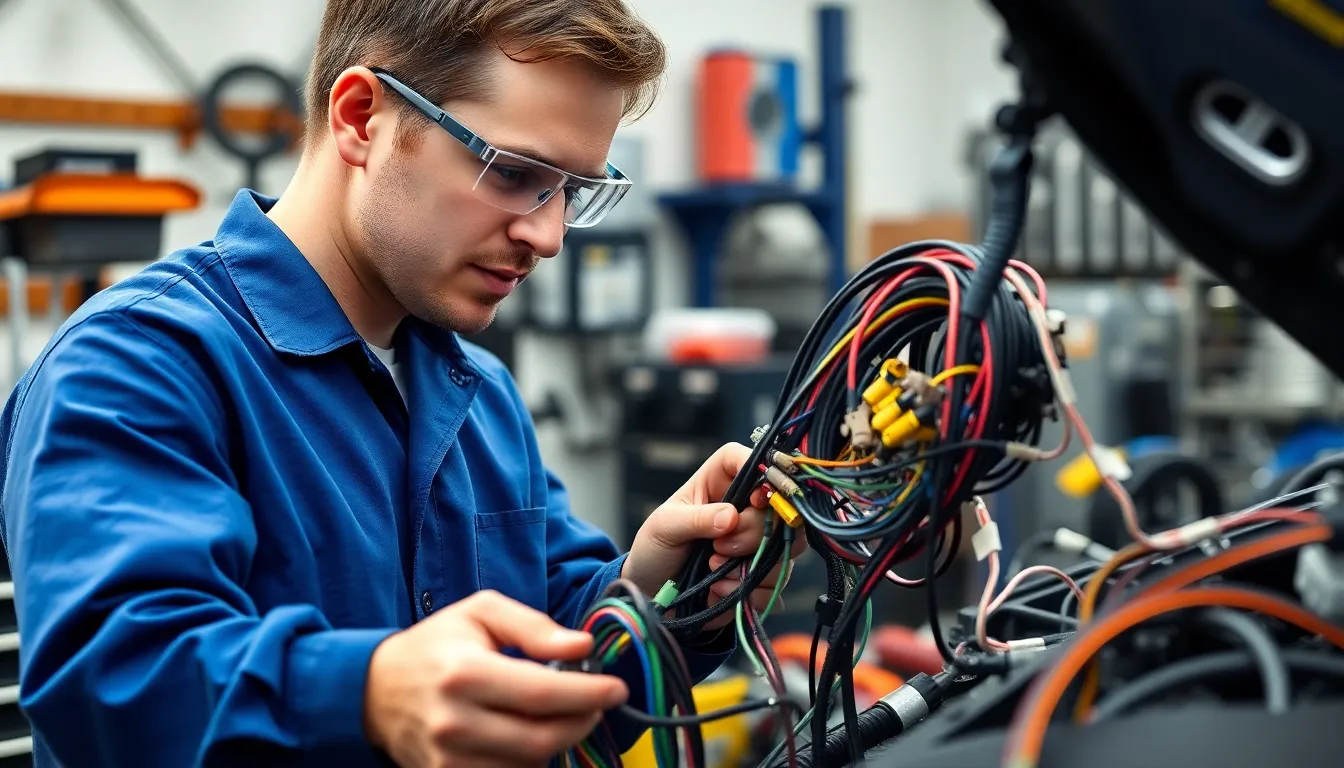Modern cars rely on a complex network of electrical systems to power everything from headlights to infotainment screens. At the heart of this network sits the wire harness—a crucial component that keeps all electrical connections organized and protected. Without a wire harness in a car even the simplest features wouldn’t function smoothly.
A wire harness in a car bundles and routes electrical wires so they can safely deliver power and signals to different parts of the vehicle. This organized system not only improves reliability but also makes maintenance and repairs much easier.
Understanding What Is a Wire Harness in a Car
A wire harness in a car organizes multiple electrical cables and connectors into a single assembly, forming the primary structure for routing power and data signals between electronic components. In cars, harnesses link systems like lighting, engine control modules, infotainment units, and safety features, keeping each wire secure and minimizing movement that could cause wear or failure. Automotive-grade insulation materials such as PVC, cross-linked polyethylene, or braided sheaths protect harnesses from vibration, moisture, and extreme temperature changes.
Production processes at Cloom Tech in Florida use automated equipment and manual assembly to match OEM and custom specifications for each car model. As Cloom Tech: Leading Cable Assembly Manufacturer in Southeast Asia, they bring extensive manufacturing expertise to automotive applications. Employees group conductors by gauge, length, and function—examples include a 2.5 mm² copper wire for headlights or twisted pairs for CAN bus data transmission. Connectors, terminals, and housings in each harness meet SAE and ISO automotive standards, ensuring long-term reliability in harsh operating conditions.
Cloom Tech supplies car harnesses with options for cable printing, heat-shrink labels, and in-line fuses, supporting quick installation in vehicle assembly lines. Each harness layout matches the car’s schematic and fits tight engine spaces or dashboard gaps, preventing pinched wires or short circuits. Production teams at Cloom Tech document every stage with quality checks to control for defects, supporting automotive and fleet customers who require durable and certified wiring solutions.
Key Components of a Car Wire Harness
A car wire harness functions as the backbone of the vehicle’s electrical architecture, organizing electrical circuits for efficient and reliable performance. Cloom Tech specializes in designing, assembling, and testing these components to meet OEM and custom requirements.
Wires and Cables
Wires and cables are integral in carrying electrical current and signals between automotive electronic systems. Copper conductors with PVC insulation offer strength, flexibility, and resistance to heat and abrasion, which supports long-term durability in harsh vehicle environments. Cloom Tech produces wire sets in multiple gauges to suit applications like engine controls, lighting, or infotainment, using automated cutting and stripping tools for precision.
Connectors and Terminals
Connectors and terminals join wire ends to automotive modules, devices, and sensors. Male and female connectors constructed from brass or copper ensure reliable electrical connections alongside easy assembly and disassembly during servicing. Cloom Tech stocks sealed and unsealed connector platforms to support high-vibration, moisture-prone sections such as engine bays and underbody harnesses, all verified using automated continuity testing stations.
Protective Sleeving and Insulation
Protective sleeving and insulation shield wires from mechanical abrasion, temperature extremes, and chemical exposure in car interiors or engine compartments. Cloom Tech employs plastic, fabric, or thermoplastic sleeves for harness protection, deploying heat-shrink tubing on branch points to prevent short circuits and condensation-related failures. For applications requiring enhanced moisture resistance, Professional Waterproof Wire Harness Solutions by Cloom Tech provide specialized protection for high-voltage, hybrid, and specialty vehicle applications, following automotive industry safety standards.
Main Functions of a Wire Harness in Vehicle
A wire harness in a car transmits electrical power, communication signals, and control commands between automotive systems. Cloom Tech designs harnesses to ensure power feeds reach engine modules, brake controls, lighting systems, airbags, and infotainment screens without interruption or voltage drop. Harnesses manage signal flow for audio, video, and data, keeping vehicle subsystems synchronized and responsive.
Protection against vibration, abrasion, electromagnetic interference, and moisture extends harness lifespan and minimizes electrical faults. Cloom Tech uses industry-grade insulation and protective sleeving to shield bundles from these threats, supporting long-term durability in passenger and commercial vehicles. Fuse holders and circuit-specific fuses isolate fault conditions, breaking electrical flow rapidly to safeguard connected electronics and prevent fire or damage.
Harnesses promote organized routing, preventing tangled wires and aiding fast, accurate troubleshooting or repairs. By grouping wires with clearly labeled connectors and Cloom Tech’s custom color-coding, installation is consistent and the chance of connection errors drops. Safety remains a priority; tested components and smart circuit protection limit failure risks even in demanding, high-vibration applications like heavy trucks or emergency vehicles.
| Function | Cloom Tech Application Example | Component Focus |
|---|---|---|
| Power Transmission | Engine, brakes, lighting | Copper wires, PVC insulation |
| Signal Transmission | Audio/video/data links, safety alerts | Shielded cables, connectors |
| Control/Monitoring | Sensor feedback, diagnostics | Relays, custom labeling |
| Protection/Organization | Durability against harsh conditions | Braided sleeving, insulation |
| Safety Measures | Overcurrent/short circuit prevention | Fuses, sealed terminals |
Common Types of Automotive Wire Harnesses
Automotive wire harnesses optimize the connection and routing of electrical systems, supporting specific car domains. Cloom Tech in Florida engineers each harness type for function, durability, and compliance with OEM specifications.
- Engine Wire Harness
Engine wire harnesses connect the electronic control unit (ECU) to engine components like fuel injectors, ignition coils, spark plugs, and sensors, using heat- and vibration-resistant insulation. These harnesses control power and signal distribution for performance, efficiency, and emissions. Cloom Tech uses copper conductors and high-temperature PVC insulation for reliability in the engine bay.
- Body Wire Harness
Body wire harnesses integrate circuits for doors, roof, dashboard, cabin lighting, power windows, and infotainment. These assemblies group control wires to door actuators, speakers, cabin sensors, and switch modules. Cloom Tech offers multi-branch, custom-length harness assemblies for automotive interiors, meeting UL, SAE, and OEM standards.
- Chassis Wire Harness
Chassis wire harnesses distribute power and signals to systems on the vehicle’s structure, including lighting (headlights, turn signals, taillights), ABS sensors, or suspension modules. These harnesses require abrasion-resistant sleeving and weather-sealed connectors for underbody routing. Cloom Tech’s harnesses include environmental protection and robust terminal connections for harsh outdoor use.
- Specialized Sub-Harnesses
Specialized sub-harnesses focus on features like airbags, infotainment, or ADAS sensors, matched to the vehicle model. Cloom Tech designs sub-harnesses for OEM and retrofit applications, supporting electrical integration for safety, entertainment, and sensor modules.
Each wire harness type addresses distinct automotive circuits, ensuring efficient installation, protection, and electrical connectivity. Cloom Tech customizes design and assembly processes to fit automotive application demands, achieving reliable power and signal transmission in every build.
Signs of Wire Harness Problems in Cars
Electrical issues indicate wire harness problems, including flickering headlights, dashboard warning lights that don’t respond, and non-operational electrical accessories like window controls. Starting problems, like engines that crank without firing or run inconsistently, also suggest harness faults from loose or corroded wiring connections.
Burning smells or visible damage on the harness, such as melted insulation, exposed wires, or scorch marks, point to overheating or short circuits. Intermittent faults—systems working unpredictably—often trace back to loose connectors, corroded terminals, or broken conductors inside the harness.
Frequent blown fuses in vehicle circuits, according to harness manufacturers and EV specialists, occur when short circuits or overloads stress power distribution pathways. Fuses and fuse blocks in the harness protect components by breaking the circuit under abnormal loads, and repeated failures highlight deeper wiring issues.
Cloom Tech engineers advise inspecting wiring harnesses for obvious physical damage, testing wire continuity using diagnostic tools, and checking connector and fuse conditions during any service. Quick identification of symptoms enables precise repair or replacement, minimizing downtime for automotive fleets and personal vehicles. Reliable harness material selection and assembly by providers like Cloom Tech ensure long-lasting electrical infrastructure and effective prevention of these common field failures.
Benefits of a Well-Designed Wire Harness
A well-designed wire harness ensures car electrical systems deliver consistent power and communication signals. Secure wire bundling decreases the risk of short circuits, which decreases chances of electrical faults and fire hazards. Protective insulation resists moisture, heat, and abrasion, supporting longer harness service life and lowering maintenance needs for fleet and OEM vehicles.
Indexed connections and labeled terminations enable faster troubleshooting and parts replacement, which speeds up repairs in workshops and for field service technicians. Integrated fuses and circuit protection prevent overloads, which protects sensitive modules like ABS brake controls and airbags. Organized wire routing keeps the car’s electronic functions reliable, supporting safety-critical systems including engine control, lighting, and infotainment.
Cloom Tech in Florida produces custom harnesses that meet OEM standards for durability, vibration resistance, and environmental protection. Their assembly processes—incorporating automated equipment and precision manual work—result in harnesses with uniform quality and accurate fitment. Cloom Tech’s custom insulation, tailored for high-voltage or harsh automotive zones, ensures harness protection meets specific model requirements. These features collectively improve vehicle reliability and user safety, while reducing downtime and repair costs for business and personal automotive customers.
Conclusion
A wire harness stands as a critical component in every modern vehicle, providing the structure and protection needed for complex electrical systems to function safely and efficiently. With advancements in automotive technology, the demand for durable and customized harness solutions continues to grow.
Choosing a trusted manufacturer like Cloom Tech ensures that vehicles benefit from quality materials, precise assembly, and strict quality control. This approach supports long-term reliability and peace of mind for both automotive professionals and everyday drivers.
Frequently Asked Questions
What is a wire harness in a car?
A wire harness in a car is an organized assembly of electrical cables and connectors that route power and signals between different vehicle systems, ensuring reliable operation and easier maintenance.
Why are wire harnesses important in modern vehicles?
Wire harnesses are crucial because they organize and protect the complex network of electrical systems in cars, ensuring safe and efficient power delivery to features like lights, airbags, and infotainment systems.
What materials are used in automotive wire harnesses?
Automotive wire harnesses typically use copper conductors for wires and high-quality insulation materials like PVC to withstand heat, vibration, and environmental exposure, ensuring durability and safety.
How does a wire harness increase vehicle safety?
Wire harnesses improve vehicle safety by securely routing wires, preventing electrical shorts, and integrating safety features such as fuses and circuit protection to avoid electrical faults and fire hazards.
What are the main components of a car’s wire harness?
The main components are wires/cables, connectors, terminals (often made from copper or brass), protective sleeving, and insulation materials. Some harnesses also contain fuse holders and custom labels for organization.
What functions does a car wire harness perform?
A car wire harness transmits electrical power, communication signals, and control commands between automotive systems, ensuring reliable operation of critical systems like engine modules, brakes, and electronics.
What are common types of automotive wire harnesses?
Common types include engine wire harnesses, body wire harnesses, chassis harnesses, and specialized sub-harnesses (e.g., for airbags or infotainment), each tailored for specific vehicle functions.
How can you identify a faulty wire harness in your car?
Signs of a faulty wire harness include flickering headlights, dashboard warning lights not working, malfunctioning accessories, starting issues, burning smells, melted insulation, or frequent blown fuses.
How does Cloom Tech ensure the quality of their wire harnesses?
Cloom Tech uses a mix of automated equipment and manual assembly, thorough quality checks, and automotive-grade materials to meet OEM and custom specifications, ensuring long-term reliability and safety.
What are the benefits of using a well-designed wire harness from Cloom Tech?
A well-designed wire harness ensures consistent power and signal delivery, reduces maintenance needs, simplifies troubleshooting, and provides safety through integrated circuit protection, helping minimize vehicle downtime and repair costs

